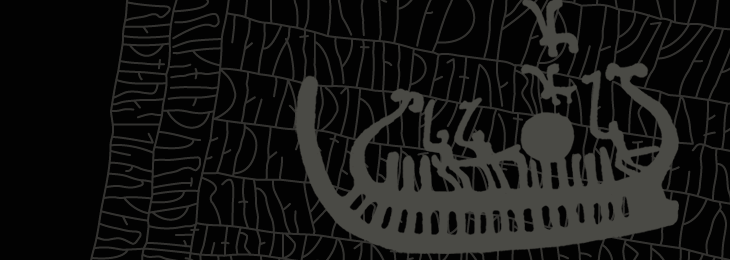What Is the Sound of Medieval Song?
By Benjamin Bagby
Originally published, in a slighter condensed version, in the Medieval Academy of America News, No. 151, (Spring 2005)
The concept of ‘historically informed performance’ thrives on the conviction that today’s musicians can find knowledge and instruction in the documentation which has survived from past musical practices: musical notation, descriptions of performance situations, treatises, methods, visual representations of music-making, playable instruments, etc. Unfortunately, all of this documentation, which we performers assiduously track down and study, is still missing the one crucial element of musical performance which we would most need and desire to possess: the actual sound, the presence of a living master. Barring the discovery of time-travel, we shall never meet our master. (And of course, there is always the terrifying sub-scenario of this time-machine fantasy: what would happen if we had access to the original sound and to the master’s living art, but we simply did not like what we heard?) Deprived of this essential face-to-face musical experience, we are forever doomed to confront our own past musical cultures ‘through a glass darkly.’
This is challenging enough in the cases of most early European repertoires, but it has obviously not kept generations of performers and scholars from fashioning a thriving early music scene, complete with venerated living musicians and identifiable traditions, so that our vision of the past seems bright and clear. However, the situation becomes much more complex and clouded when we seek to perform medieval song. We sometimes know how this music was performed, but we will never know how it sounded.
Most of us enjoy listening to recordings of medieval monophonic song and attending live concerts, the majority of which present medieval repertoires in the guise of a straightforward and polished chamber music concert. And yet, in today’s world of medieval music one can also encounter the concert as meditative pseudo-liturgy; as ironic, edgy cabaret; as ponderous mystery play or cute, costumed courtly entertainment; as ecstatic ethnic hum-along; as dutiful list of musical examples; or as Society for Creative Anachronism free-for-all. In short: medieval song, having no ancient living traditions of its own, thrives even in the harshest of environments and adapts easily to the disguises we performers require it to inhabit.
I refer here to monophonic song (including Western liturgical chant), since these are the repertoires which have provoked the most debate (and discord) among proponents of various theories of how such music might have sounded 700, 800 or even 1000 years ago. Monophonic song is situated at the volatile crossroads of oral tradition and the scriptorium, of voices and instruments, of Latin and the vernacular, and is the principal vehicle for musical practices which rarely, if ever, were described by medieval musicians in a manner that speaks to our condition. Over the years, generations of musicians have tried to bring these repertoires back to life, with predictably uneven results.
Both performers and musicologists would like to believe that our efforts to understand these medieval repertoires are inexorably leading us closer and closer to modern performances which we might be justified in labelling ‘historically informed’. Yet in fact, many of the forces which are helping to shape the way musicians of the 21st century perform medieval music are anything but historical. The perceived demands of the public (‘the market’), and the contemporary tastes and intuitions of the performers themselves inform today’s music-making as much as any medieval sources. Today’s medieval performers, all of us musical survivalists, have had to learn to combine economic reality with our desire to recreate a convinving sounding image of the past.
It it the principal medium of that sounding image – the vinyl LP, followed by the CD and the technologies which will replace the CD – which has increasingly become the potent instrument calling the tune of how medieval music will sound in our time. The classical recording industry, whose recent woes are well known to all, has changed radically from the days when an LP recording of medieval music was considered a success if it sold a few hundred copies. By today’s standards, these early recordings had laughably modest budgets, the packaging was subdued and scholarly, and the performers were relatively unknown. The expansion of interest in medieval music, and the presence on the scene of certain charismatic performers during the 1960’s and 70’s, began to change the way medieval music was studied, performed, recorded and perceived by its listeners.
But it was the appearance of the CD and the subsequent huge opening of the market for recorded sound in the 1980’s and 90’s which transformed the situation dramatically. This period of commercial expansion also witnessed the phenomena of ‘Chant mania’ (millions of CDs sold, mostly to kids) and the obscuring of the borders between medieval music and ‘New Age’ (medieval music as a source of relaxation for adults, and a harbinger of the ‘crossover’ market yet to come). Recording budgets increased, packaging became more lavish and professional, and we saw the emergence of a canon of medieval works which, like Vivaldi’s Four Seasons, could be profitably recorded again and again without saturating the market: the Cantigas de Amigo of Martin Codax, the Messe de Notre-Dame of Guillaume de Machaut, the Play of Daniel, the Cantigas de Santa Maria of Alfonso el Sabio, and the works of Hildegard von Bingen.
Along with the canon, there is the modern phenomenon of the fixed ‘medieval ensemble’, a group usually consisting of three or four performers, forced to accommodate itself to a huge variety of repertoires. Clearly a structure inherited from the world of classical chamber music, rock bands and the folk revival, these small ensembles turn out to be an economic necessity as well: such compact groups can tour in a cost-effective way (for instance: they fit into one taxi). More significantly, the proliferation of trios and quartets has helped set norms for sound quality and performance practice which listeners have come to accept as the ‘sound’ of medieval music. These ensembles tend to fall into two categories: same-sex ensembles of vocalists, with a sound ideal which stresses homogeneity and perfect tuning, and mixed groups of singers and instruments which tend to encourage the image of medieval solo song as chamber music. However, I think most historians would doubt that medieval Europe was in the thrall of a half-dozen professional touring ensembles, each consisting of a handful of attractive, literate and well-nourished men and women in their 30’s and 40’s, with all their teeth intact.
Along with recordings, the institution of the concert also informs our perceptions of the performance of medieval music. Audience expectations for the overall concert experience – comfortable, well-lit churches, chapels and concert halls, program notes, pre-concert lectures, an atmosphere of reverent silence and standardized concert length – have had an influence on the presentation of medieval music. For example, in dealing with the confrontation between medieval and modern concepts of time, today’s musicians have been forced to make tortured decisions, truncating extremely long or repetitive pieces (liturgical chant, long poems) so that the program does not seem excessively ‘austere’ or ‘monotonous’ and thereby alienate the audience, or worse, the presenter (almost all advertising for medieval concerts contains the reassuring code-phrase ‘rich and varied’). This fear of alienation is a slippery slope descending towards the ridiculous, as any ensemble which has tried dressing up in pointy shoes and pretending to be ‘medieval’ can attest. In recordings made today (also limited in time: a maxed-out CD holds 74-minutes), we expect pristine acoustics, utter silence in the pauses, and perfection in sound-quality, all bearing witness to the heavy classical-music baggage which medieval musicians must schlepp with them. We have placed each piece we record in the digital equivalent of a sanitized and well-labeled, bulletproof glass exhibition case, and we cannot seem to imagine another reality than this one.
The 1990’s witnessed the emergence of succesful medieval ensembles whose popularity proved that medieval music could penetrate even the highest echelons of the classical music world. For those who have thus escaped from the ‘early music ghetto’ into the musical mainstream, this well-deserved recognition and freedom can be a mixed blessing. The sophisticated marketing of recordings (or, to use record-company jargon: ‘the product’), has further helped to raise the expectations of critics, listeners, and other performers for these prominent groups as they work to remain artistically viable (and physically healthy) under the heavy burdens of recording, promoting, touring, and preparing new projects. As the recording industry’s expansion into new markets increases, we find some performances of medieval music appearing in the ‘crossover’ category, and productions in which early repertoires are mixed with traditional music, improvised music, or with contemporary works written especially with the performers’ unique abilities and sound in mind. In this, the next generation of aspiring young performers has found new ‘medieval’ role models.
What do we really know about the sound of medieval music? We know that it is the sound of our own ‘historically informed imaginations’ as we view the past through the powerful lens of the present.


